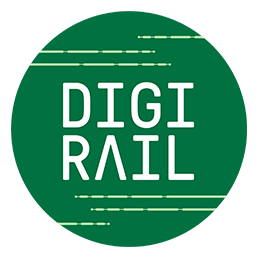The Digirail project is testing a new positioning system based on satellite positioning technology. With the aid of test equipment installed in the engine, it will be possible to determine the location of trains much more precisely than before. In particular, this functionality is being tested in environments that are more challenging in terms of positioning.
Finland’s current train control system (JKV) is approaching the end of its lifecycle. It will be upgraded to a European Train Control System (ETCS). ETCS train positioning is based on a train’s distance from reference points. Balises or other suitable points on the track are used as reference points. Balises are train control components that are placed between the rails. When a train passes a reference point, the accuracy of the train’s positioning is checked, any errors are corrected, and a distance measurement from the new reference point is begun.
The current system does not provide very precise information about the location of trains, as safe train control is based on ensuring that track segments are free of other traffic, not on train location data. For safety reasons, each train reserves an entire section of track that can be up to dozens of kilometres in length. In the current system, increasing capacity is challenging, if not impossible. The ETCS’s safety solution includes train positioning systems that will enable trains to run closer together, and thereby also increase capacity.
This Digirail subproject is exploring different techniques and alternatives to more accurately determine the position of trains, including their advantages and disadvantages. The aim is to specify the minimum requirements for a safe and accurate positioning system, and to test a system that meets these requirements. The project has now reached the installation and testing phase.
“By harnessing modern technology and, for example, solutions from the automotive industry, a train will be able to transmit its exact location to the system. There will no longer be a need for axle counters or electric circuits, which are expensive to maintain and replace. Neither will trains need such long safety margins, which will allow them to run closer together. This will enable us to increase capacity and streamline rail traffic,” says Esa Mäkelä, Senior Rail Advisor at WSP Finland and Project Manager for the new Digirail positioning project.
Test runs launched in November
The test equipment has been installed in an Sr2 engine. Radar has been installed in both the front and rear of the engine, and antennas have been placed on the roof. A computer, network disk and multichannel router have also been installed in the machinery space.
“The sensor package includes RTK-assisted satellite positioning technology (Real-Time Kinematics), which can provide real-time positioning to a centimetre-level of accuracy. This new system will be separate to, and used separately from, the engine’s other existing systems,” says Ville Väisänen, Project Manager at VR FleetCare.
After the functionality of the installed equipment had been tested, the engine was handed over for a commercial traffic pilot at the end of October. Test runs will be made in at least the Tampere, Jyväskylä and Oulu regions. The aim of these runs is to test how well positioning works, and especially in areas with forests, fields, tunnels, rock cuts or railyards.
The first stage of testing will last several months. Wintertime tests are also essential. After the initial results have been evaluated, more test runs may be made.
“It’s great that the Digirail project is enabling us to carry out experiments that have the potential to develop the railway system on a solid technical foundation. In addition to capacity benefits, accurate and reliable positioning also opens up great potential for improving the safety of shunting and trackwork over the longer term,” says Jonas Eriksson, VR’s project manager.
New European legislation in the pipeline
This project is also topical at an international level, as current European railway legislation does not contain any regulations on the requirements for modern positioning systems. Legislation governing train positioning systems is therefore in the process of being developed at a European level. The aim is to introduce regulations that will enable the use of modern technology in train positioning.
“At the moment, Europe is discussing possible solutions and requirements for positioning systems, and is exploring various technologies. Satellite positioning is playing a significant role in these tests. In the Digirail project, we want to test which technologies work best in Finnish conditions in particular, as this will ensure smoother traffic here in the Nordic countries as well,” says Mäkelä.


